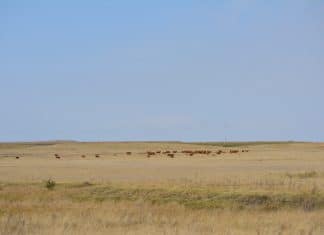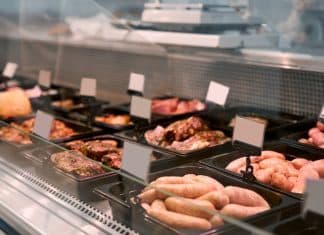Estimated reading time: 8 minutes
- Father-and-son team, John and James Miller, run a Merino flock and a South Devon herd on Winston Farms. They were nominated for the 2023 ARC Beef Performers Awards’ National Best Elite Cow award for their South Devon herd.
- James says fertility, milk production, growth, good temperament and outstanding maternal traits are among the most beneficial attributes of the South Devon breed.
- The herd has an average intercalving period (ICP) of 366 days. The Winston herd was recently awarded the Nieubaden Trophy for the lowest ICP in the South Devon breed.
- “You need to produce a product that performs in the feedlot,” says James. “Once you have a product that is easy to market, you can tweak your farming practices and the genetics of these animals to produce this product more economically”.
- Always keep in mind why you have chosen certain animals to breed, says James. The Millers strive to produce heifers that will outperform their predecessors.
Winston Farms is situated on sourveld near Cathcart and Hogsback in the Amatole Mountains in the Eastern Cape, an area ideally suited to hardy sheep and cattle.

Here the father-and-son team, John and James Miller, run a Merino flock as well as a South Devon herd, the latter of which was nominated by the Agricultural Research Council (ARC) as a finalist and winner in the 2023 ARC Beef Performers Awards’ category, National Best Elite Cow.
Read more about the 2023 ARC National Beef Performers Awards.
Economical stock
James says fertility, milk production, growth, good temperament and outstanding maternal traits are among the most beneficial attributes of the South Devon breed. “We believe these are what makes a cow productive, and plan to continue to fine-tune these traits in our herd to remain economically proficient.” They view maternal traits, which are passed on to the heifers, as an ongoing cycle – each cow delivers a calf with the least effort, right from conception to weaning, while producing a calf every year. Years of following strict selection methods have contributed to fertile animals in the Winston South Devon herd, which has maintained an average conception rate of 95% in the last five years. This is why they decided to only retain animals that conceive within 60 days and have had an average 60-day conception rate of 94% over the last three years.
The herd has an average intercalving period (ICP) of 366 days. The Winston herd was recently awarded the Nieubaden Trophy for the lowest ICP in the South Devon breed. James emphasises the fact that their beef operation must support itself and does not rely on profits from other entities to float them financially. It is therefore important to know where one’s cattle genetics come from and how profitable that entity is.
“Milk is the single most important attribute in a maternal cow, and without milk it is impossible to produce beef,” says James. “Anyone can produce heavy weaners, but no one can beat the efficiency of a naturally proficient, milk producing mother.”
Drivers of profit
The Millers used statistics from SA Stud Book’s South Devon Annual Report for the year ending December 2022, to show that the South Devon is at the top of the list in terms of the shortest average ICP among beef breeds in the country. The ICPs across the South Devon breed currently average 376 days compared to a beef cow average of 410 days. That is on average 34 days shorter than the rest of the beef industry in South Africa. Taking 34 days at 1kg/day at R35/kg works out to an additional R1 190/cow/year.
“You need to produce a product that performs in the feedlot,” says James. “Once you have a product that is easy to market, you can tweak your farming practices and the genetics of these animals to produce this product more economically. Farming an animal that is tough to market limits the profit you can generate. As beef producers we always strive for the former.”
Accurate record-keeping, performance testing and strict selection criteria are applied to improve cattle performance, thereby enhancing the functional efficiency of the cow herd to produce a heavy and healthy calf every year. “The first and most important selection criteria is visual selection to ensure that animals can walk, feed and reproduce. Animals with physical impairments that inhibit their ability to walk, feed and reproduce are culled.”
From James’ point of view, having access to estimated breeding values (EBVs) is very advantageous as they are backed by accurate records. This makes selecting animals for breeding that much easier. “It gives us an idea of how that animal will breed, and in this case predictability is key. Genetics is a funny thing, and it is very hard to predict how animals will breed. But EBVs have allowed us to be more accurate when selecting animals, and I believe this will help us to reach our breeding goals quicker.”

Bred in a natural environment
Always keep in mind why you have chosen certain animals to breed, says James. The Millers strive to produce heifers that will outperform their predecessors. “Improving by small margins year-on-year, we will eventually get close to our goal,” says James.
“The by-product of this is that the other half of the calf crop happens to be bulls. If these animals are bred in our natural environment, they are bound to produce progeny that perform in the same natural environment and under the same management system. This presents us with the opportunity to supply commercial producers with seed stock for their herds in the form of bulls sold at our annual bull sale.”
However, it is imperative that their cattle branch remains profitable as a weaner producer. In this regard, the business does not depend on bull sales to remain profitable. “As soon as this happens, the temptation is there to breed bulls for the bull sale, which means you lose sight of the role your heifers play,” says James.
Top selection criteria
Adaptability is a term that is very hard to measure and put a value to. An animal’s ability to thrive in a specific environment and under a specific management system makes it, according to James, an adapted animal. It is a trait they have started selecting for by mating all their heifers at 14 months old.
“We’ve only been doing this for the last four years and so far, the adapted animals conceive at 12 to 14 months, calve at 21 to 23 months, wean their first calf, and reconceive by the age of 27 to 30 months. We try to keep the mating as natural and the season as compact as possible.”
The Miller’s top selection criteria – past, present and future – are:
- Past: fertility and growth records.
- Present: visual aspects (walking ability, feeding and reproduction).
- Future: EBVs, milk production and growth.
Results to date:
- Average conception (45-day mating): 73,3%.
- Average weaning weight (205 days): 221kg.
- Average re-conception (60 days): 82%.
- Average re-conception (90 days): 95%.

Monitoring of costs and margins
Each year has its challenges as inputs will vary according to rainfall and weather conditions. The Millers draw up a detailed annual budget which they monitor monthly to make sure margins are achieved where possible. According to James, the regular monitoring of costs and margins enables them to think of different ways to improve and optimise efficiency.
“The beef industry is going to have to adapt. I think within the next 15 years, approximately 80% of beef producers will have made the shift to mating at 14 months. Economically, why wait to get your first return from an asset after 40 months when you could be getting a return from the same asset after 28 months?”
A large portion of the industry won’t even consider early mating because they say either their farm or herd won’t be able to do it. James begs to differ. “We have to start identifying animals that can do it in our herds and start selecting for the traits that will give us the economic advantage to go forward.” – Carin Venter, Plaas Media
For more information, contact James Miller on 082 517 4887 or james@winstonfarms.co.za.







